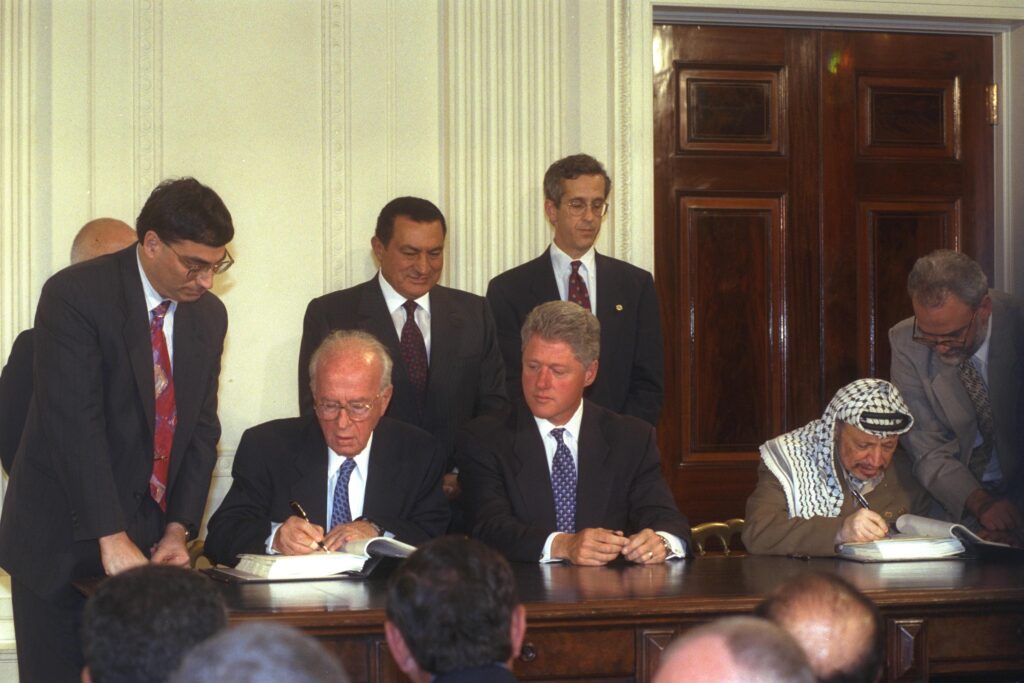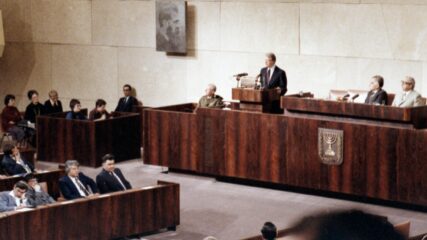September 28, 1995
After signing the Declaration of Principles (DOP) on Interim Self-Government Arrangements, commonly known as the Oslo Accords, on September 13, 1993, Israel and the PLO reached three additional interim agreements before Oslo II:
- On May 4, 1994, the Gaza-Jericho Agreement, also known as the Cairo Agreement, which implemented the provisions of the DOP, the withdrawal of the Israeli military from the Gaza Strip and the Jericho area, and the transfer of powers from the Israeli military government to the Palestinian Authority.
- On August 29, 1994, an agreement providing for the transfer of six civil spheres to the Palestinian Authority.
- On August 27, 1995, an agreement providing for the transfer of an additional eight spheres of authority.
On September 28, 1995, they signed the Interim Agreement for the West Bank and Gaza Strip, or Oslo II, which broadly extended Palestinian self-governing arrangements throughout the West Bank. It contained detailed arrangements for the election of a Palestinian self-governing authority with a council and a president. It also provided for the transfer of powers and responsibilities to the council from the Israeli government and Israeli civilian administration, contained extensive security arrangements, stipulated relations between Israel and the Palestinian Council in legal and economic matters, and generally encouraged cooperation between the sides.
Oslo II ran for more than 400 pages, including seven annexes and maps. Notably, the source of all authority for the Palestinian Council remained the Israeli military administration, and both sides agreed that neither would act to change the status of the West Bank and Gaza Strip pending the outcome of the permanent-status negotiations, which were to be completed, but were not, by May 4, 1999. Interim arrangements were not supposed to prejudice permanent-status conclusions.
Neither the Oslo Accords signed two years earlier nor this agreement nor the several interim agreements signed promised the establishment of a Palestinian state.
Copious details were provided for the conduct of the Palestinian elections and the structure of the Palestinian Council, its prerogatives, jurisdiction and legislative powers. The Palestinian Council and presidential elections were held with the stipulated international supervision January 20, 1996. The first phase of Israeli redeployment from the major Palestinian cities took place as scheduled before those elections, with the notable exception of a full Israeli withdrawal from Hebron. Israel did promise further withdrawal from Hebron in the 1998 Wye River Agreement. Subsequent withdrawals were to take place at six-month intervals and were to be completed 18 months after the council’s inauguration in March 1996), or by July 1997.
In 1996, serial bombings against Israeli civilians in February and March, the election of a Likud government in May, and outbursts of Palestinian-Israeli violence in September were among the reasons why the subsequent Israeli withdrawals did not take place on time. In 1998, Israel and the PA agreed after nine days of negotiations to uphold all the agreements within the Oslo Accords in the Wye River Agreement. Both sides promised not to engage in unilateral actions, which was quickly broken by both sides. By 1999, PA and PLO leader Arafat unilaterally suspended the prerogatives of the elected Palestinian Legislative Council, keeping most authority to himself. At the end of the Clinton administration concerted efforts were made to move Palestinian-Israeli talks toward a political horizon that would bring the conflict to an end, but those efforts failed, which slid toward the onset of the Second Palestinian Intifada, or uprising, against Israeli presence in September 2000. Once again, Palestinian-Israeli communal violence was interrupted by pauses for discussion and agreement signing, then episodic violence and unilateral actions resumed.
— Ken Stein, September 2025









